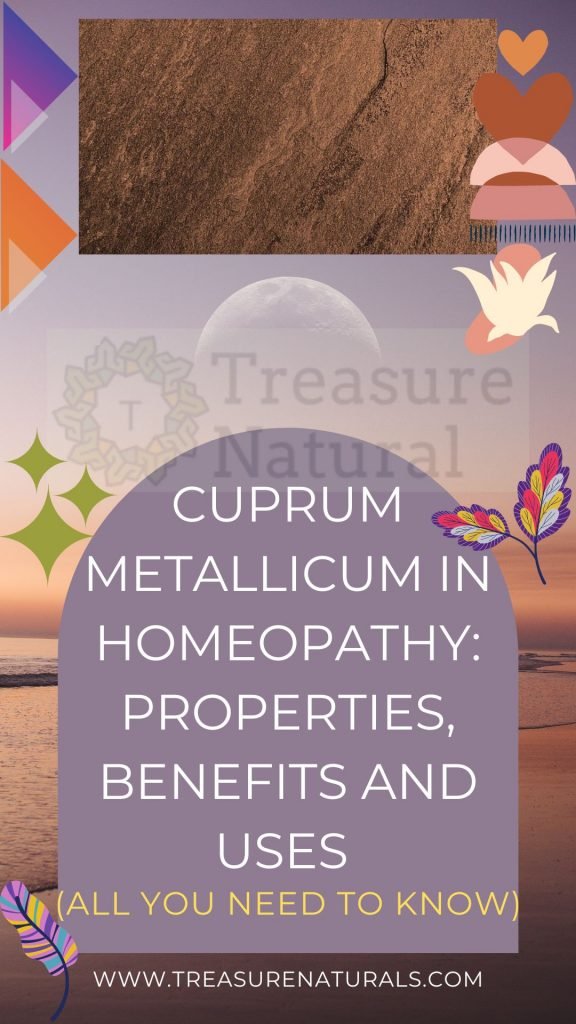
The homeopathic remedy Cuprum metallicum is obtained from reduced copper powder. This rocky metal, also called “red gold” because of its coloring, is present in many foods and is essential for bone growth. In Homeopathy it is used for pathologies and disorders affecting the nervous system and respiratory system.
Cuprum metallicum: the properties of copper
Copper is a chemical element present in the table of elements with the symbol Cu that derives from the “Cuprum“, from which the homeopathic remedy Cuprum metallicum also takes its name. It is a very important metal-micronutrient for all higher living organisms. In particular, in the human body, it plays a fundamental role for the proper functioning of different enzymes, participating in the proper functioning of energy metabolism, the production of red blood cells, bones and connective tissues. Copper is also involved in the pigmentation of skin and hair, affects the proper functioning of the heart and is able to counteract the damage to cells caused by free radicals thanks to its antioxidant action.
The human body contains on average 1.4 – 2.1 mg / kg of copper distributed mainly between the liver, muscles and bones. The requirement required by our body is moderate, since it is difficult for a deficiency of this substance to occur. Foods that contain high amounts of copper are offal or entrails of animals, molluscs and crustaceans, oilseeds such as walnuts, hazelnuts, almonds, cashews and peanuts. The absorption of copper in the human body occurs through the intestine and depends not so much on the presence of this substance in food, but on the composition of meals.
Copper ores are found naturally in the earth’s crust in various forms and concentrations. The places where it is most present are Chile, Peru, China, the United States, Congo, Zambia and Mexico.
In ancient times, copper was the first metal used to make everyday utensils and weapons, but also for the preparation of medicinal ointments to soothe wounds. Those who worked closely with this metal suffered from ailments such as colic, coughing and malnutrition, giving rise to the suspicion that copper was toxic. In fact, taken in high doses, copper can cause seizures, paralysis and, in severe cases, even death.
Cuprum metallicum: homeopathic remedies and properties
In Homeopathy the remedy Cuprum metallicum has been tested since 1834 observing the beneficial action it exerts on the nervous system. It is still used to treat cramps that begin with spasms and convulsions in the toes and radiate to the ankles and calves. In this sense, the homeopathic remedy Cuprum is indicated for both acute and chronic disorders and for pathologies such as epilepsy with muscle spasms and convulsions, but it is also used in case of mental fatigue that leads to tiredness and exhaustion.
Cuprum is a remedy that also acts on the respiratory system soothing pathologies such as asthma and whooping cough.
Compared to its pathogenic action, historically it was used in allopathy to treat cholera. As has already been mentioned, excess free copper in the body has toxic action. Acute copper intoxication causes vomiting, liver necrosis, hemolysis, oliguria and coma. Chronic intoxication corresponds to Wilson’s disease (genetic defect of ceruloplasmin) with cirrhosis of the liver, corneal changes, degeneration of the nuclei of the base with the appearance of spasms, tremors and speech difficulties.
The remedy was tested by Hahnemann who highlighted a pathogenic action similar to the picture of chronic intoxication and characterized by:
- cramps, spasms, tetany and tonic-clonic seizures
- digestive and respiratory spasms: abdominal colic, diarrhea, spasms of the glottis, spasmodic cough, acute asthma.
Modality
The Cuprum type is subject to aggravation:
- after one or more sleepless nights
- after physical or intellectual fatigue
- at night or when you wake up
- with the full moon
- with contact
Improve by drinking cold water and sweat.
The constitutional type Cuprum metallicum

The constitutional type is a subject characterized by a serious and seemingly composed attitude. In fact, they tend to repress deep emotions and feelings to the point of letting themselves go to unpredictable reactions. For this reason, they are considered unreliable precisely because of their unsteady nature. In Cuprum types the inability to manage emotions manifests itself at a young age, with the suppression of the first sexual impulses. Finally, other distinctive features that characterize this constitutional type are a markedly destructive attitude and the inability to stay close to others by holding your breath in anger, until you become cyanotic.






